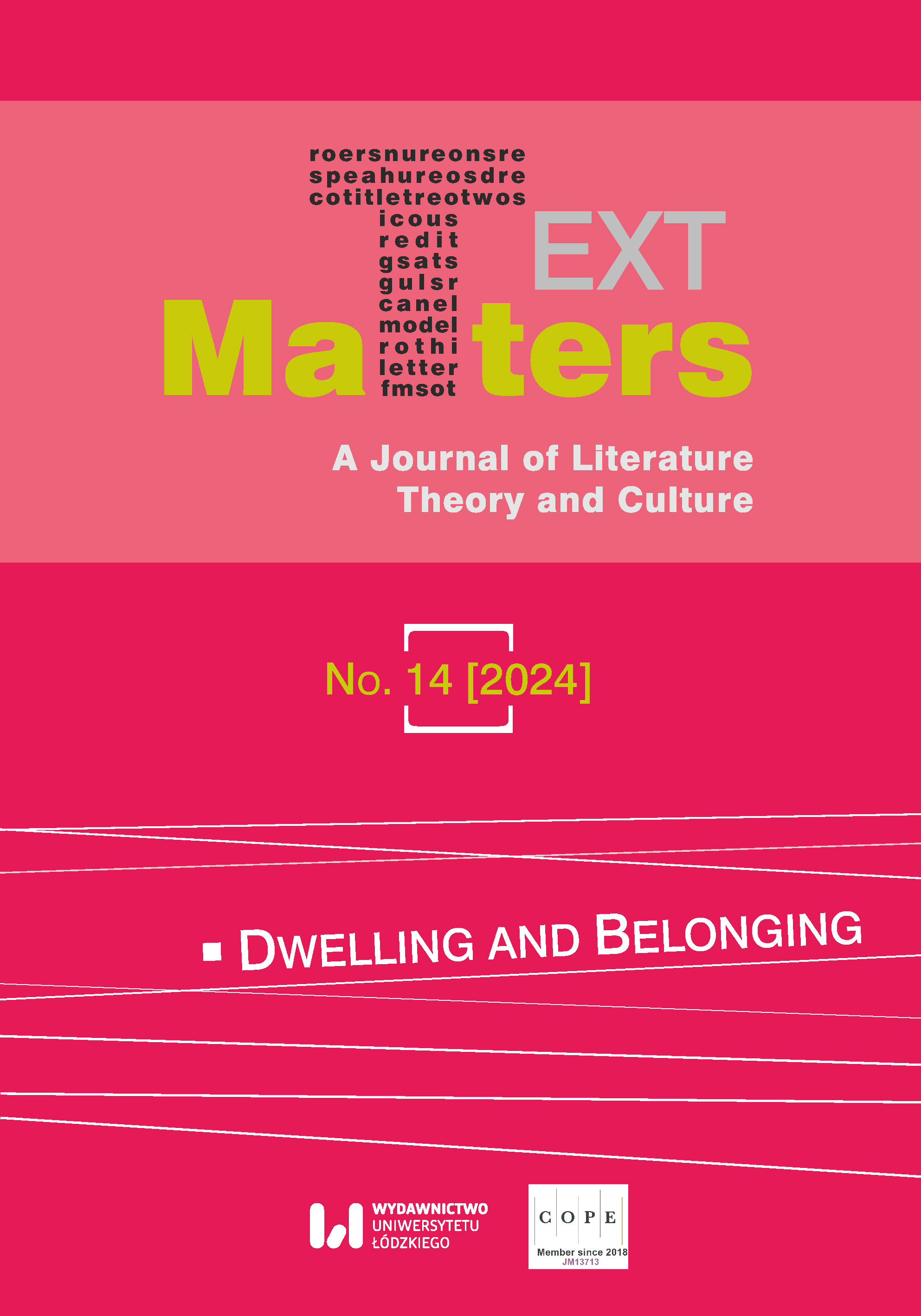Cathartic Paths of the Gothic in Ciemno, prawie noc by Joanna Bator
DOI:
https://doi.org/10.18778/2083-2931.14.06Keywords:
Joanna Bator, the Gothic, new urban Gothic, trauma, catharsisAbstract
The aim of this paper is to investigate how the Gothic is employed in Joanna Bator’s novel Ciemno, prawie noc [Dark, Almost Night]. I frame my analysis on the author’s assertion that “Poland is a horror,” exploring firstly how the Gothic serves as an aesthetic framework that intertwines different time periods and family histories within the narrative. Secondly, I examine its role in grounding these temporal layers within the specific geographical location of Wałbrzych, which itself assumes a villain-like presence in the novel. I argue that Bator adapts the Gothic tradition for cathartic purposes, particularly in narrating transgenerational traumas. This approach enables the expression and understanding of a fractured past, potentially fostering a process of healing.
Downloads
References
Abraham, Nicolas, and Maria Torok. The Shell and the Kernel. Volume 1. Edited and translated by Nicholas T. Rand, Chicago UP, 1994.
Google Scholar
Alder, Emily. “Urban Gothic.” The Encyclopedia of the Gothic, edited by Andrew Smith, David Punter and William Hughes, Wiley Blackwell, 2015, pp. 703–06.
Google Scholar
Bator, Joanna. Ciemno, prawie noc. WAB, 2013.
Google Scholar
Caruth, Cathy. “Trauma and Experience: Introduction.” Trauma: Explorations in Memory, edited by Cathy Caruth, The Johns Hopkins UP, 1995, pp. 3–12. https://doi.org/10.56021/9781421413525
Google Scholar
DOI: https://doi.org/10.56021/9781421413525
Caruth, Cathy. Unclaimed Experience: Trauma, Narrative and History. The Johns Hopkins UP, 1996. https://doi.org/10.1353/book.20656
Google Scholar
DOI: https://doi.org/10.1353/book.20656
Czapliński, Przemysław. “Nowa powieść Joanny Bator. Alicja w krainie strachów.” Gazeta Wyborcza, 30 Oct. 2012, https://wyborcza.pl/7,75410,12762841,nowa-powiesc-joanny-bator-alicja-w-krainie-strachow.html accessed 24 Jan. 2023.
Google Scholar
Dunin, Kinga. “Dunin o laureatce Nike.” Krytyka Polityczna, 6 Oct. 2013, https://krytykapolityczna.pl/kultura/czytaj-dalej/kinga-dunin-czyta/dunin-o-laureatce-nike/ accessed 24 Jan. 2023.
Google Scholar
Eigler, Friederike. “Introduction: Moving Forward: New Perspectives on German-Polish Relations in Contemporary Europe.” German Politics & Society, vol. 31, no. 4, 2013, pp. 1–15. https://doi.org/10.3167/gps.2013.310401
Google Scholar
DOI: https://doi.org/10.3167/gps.2013.310401
Freud, Sigmund. “Remembering, Repeating and Working Through.” 1914. The Standard Edition of the Complete Psychological Works of Sigmund Freud, Volume 12, edited by James Strachey, Hogarth, 1981, pp. 147–56.
Google Scholar
Kuszyk, Karolina. Poniemieckie. Wydawnictwo Czarne, 2019.
Google Scholar
McNally, Richard. Remembering Trauma. Harvard UP, 2005. https://doi.org/10.2307/j.ctv1pdrpxm
Google Scholar
DOI: https://doi.org/10.2307/j.ctv1pdrpxm
Mighall, Robert. A Geography of Victorian Gothic Fiction: Mapping History’s Nightmares. Oxford UP, 1999.
Google Scholar
Mighall, Robert. “Dickens and the Gothic.” A Companion to Charles Dickens, edited by David Paroissien, Blackwell, 2008, pp. 81–96. https://doi.org/10.1002/9780470691908.ch6
Google Scholar
DOI: https://doi.org/10.1002/9780470691908.ch6
Millette, Holly-Gale. “The New Urban Gothic: Introduction.” The New Urban Gothic: Global Gothic in the Age of the Anthropocene, edited by Holly-Gale Millette and Ruth Heholt, Palgrave Macmillan, 2020, pp. 1–18. https://doi.org/10.1007/978-3-030-43777-0
Google Scholar
DOI: https://doi.org/10.1007/978-3-030-43777-0_1
“Nagroda Literacka Nike 2013 dla Joanny Bator za powieść ‘Ciemno, prawie noc.’” Booklips, 6 Oct. 2013, https://booklips.pl/newsy/nagroda-literacka-nike-2013-dla-joanny-bator-za-powiesc-ciemno-prawie-noc/ accessed 20 Jan. 2023.
Google Scholar
Onega, Susana. “Victimhood.” The Routledge Companion to Literature and Trauma, edited by Colin Davis and Hanna Meretoja, Routledge, 2020, pp. 91–99. https://doi.org/10.4324/9781351025225-8
Google Scholar
DOI: https://doi.org/10.4324/9781351025225-8
Punter, David. “Introduction: Of Apparitions.” Spectral Readings: Towards a Gothic Geography, edited by Glennis Byron and David Punter, Macmillan, 1999, pp. 1–8. https://doi.org/10.1057/9780230374614_1
Google Scholar
DOI: https://doi.org/10.1057/9780230374614_1
Punter, David. “On the Threshold of Gothic: A Reflection.” The Gothic and Theory: An Edinburgh Companion, edited by Jerrold E. Hogle and Robert Miles, Edinburgh UP, 2020, pp. 301–19. https://doi.org/10.3366/edinburgh/9781474427777.003.0016
Google Scholar
DOI: https://doi.org/10.3366/edinburgh/9781474427777.003.0016
Ricœur, Paul. Memory, History, Forgetting. Translated by Kathleen Blamey and David Pellauer, U of Chicago P, 2004. https://doi.org/10.7208/chicago/9780226713465.001.0001
Google Scholar
DOI: https://doi.org/10.7208/chicago/9780226713465.001.0001
Sage, Victor. Horror Fiction in the Protestant Tradition. Macmillan, 1988. https://doi.org/10.1007/978-1-349-19432-2
Google Scholar
DOI: https://doi.org/10.1007/978-1-349-19432-2
Snyder, Timothy. “The Historical Reality of Eastern Europe.” East European Politics and Societies, vol. 23, no. 1, 2009, pp. 7–12. https://doi.org/10.1177/0888325408328750
Google Scholar
DOI: https://doi.org/10.1177/0888325408328750
Published
Versions
- 2024-11-28 (2)
- 2024-11-28 (1)
How to Cite
Issue
Section
License

This work is licensed under a Creative Commons Attribution-NonCommercial-NoDerivatives 4.0 International License.













